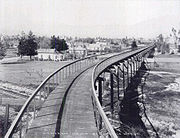
California Cycleway
Encyclopedia

Bicycle
A bicycle, also known as a bike, pushbike or cycle, is a human-powered, pedal-driven, single-track vehicle, having two wheels attached to a frame, one behind the other. A person who rides a bicycle is called a cyclist, or bicyclist....
traffic through the Arroyo Seco
Arroyo Seco (Los Angeles County)
The Arroyo Seco, meaning "dry stream" in Spanish, is a seasonal river, canyon, watershed, and cultural area in Los Angeles County, California, United States. The Arroyo Seco has been called the most celebrated canyon in Southern California.-River course:...
, intended to connect the cities of Pasadena
Pasadena, California
Pasadena is a city in Los Angeles County, California, United States. Although famous for hosting the annual Rose Bowl football game and Tournament of Roses Parade, Pasadena is the home to many scientific and cultural institutions, including the California Institute of Technology , the Jet...
and Los Angeles
Los Angeles, California
Los Angeles , with a population at the 2010 United States Census of 3,792,621, is the most populous city in California, USA and the second most populous in the United States, after New York City. It has an area of , and is located in Southern California...
, in California
California
California is a state located on the West Coast of the United States. It is by far the most populous U.S. state, and the third-largest by land area...
, United States
United States
The United States of America is a federal constitutional republic comprising fifty states and a federal district...
.
The inventor and promotor of the cycleway was Pasadena resident Horace Dobbins
Horace Dobbins
Horace Dobbins was Mayor of Pasadena, California, United States in 1900-1901. He was known for building the California Cycleway from Pasadena to Los Angeles.-External links:...
, who attracted ex-California governor Henry Harrison Markham to join him in the scheme. Together, the two sought approval from the California state legislature, which was ultimately granted (after a first attempt was vetoed) in 1897. The California Cycleway Company bought a six-mile (10 km) right-of-way from downtown Pasadena to Avenue 54 in Highland Park, Los Angeles
Highland Park, Los Angeles, California
Highland Park is a neighborhood in Northeast Los Angeles.-Geography:Highland Park is located along the Arroyo Seco. It is situated within what was once Rancho San Rafael of the Spanish / Mexican era...
. Construction began in 1899, and about 1.3 miles (2 km) of the elevated wooden bikeway were opened on January 1, 1900, starting near Pasadena's Hotel Green
Hotel Green
Historical information with regards to the fire that brought the old Hotel Green wooden structure down, is credited to the book Haunted Houses of Pasadena by Michael J. Kouri, a well known historian and Parapsychological Investigator....
and ending near the Raymond Hotel. The majority of its route is now Edmondson Alley. A toll booth was located near the north end, in the present Central Park. Had the full route been completed, it would have continued past Highland Park, on through Montecito Heights, crossed the Los Angeles River
Los Angeles River
The Los Angeles River is a river that starts in the San Fernando Valley, in the Simi Hills and Santa Susana Mountains, and flows through Los Angeles County, California, from Canoga Park in the western end of the San Fernando Valley, nearly southeast to its mouth in Long Beach...
, passed Elysian Park, and continued to the Plaza
Los Angeles Plaza Historic District
The Los Angeles Plaza Historic District, also known as El Pueblo de Los Angeles State Historic Park, is a historic district located at the oldest section of Los Angeles, known for many years as "El Pueblo de la Reina de Los Angeles"...
in Los Angeles. The full nine-mile run would have had a maximum grade of 3% and an average grade slightly over 1%. At its highest point, the elevation of the roadway was 50 feet.
The portion built was constructed almost entirely of Oregon pine and was wide enough for four cyclists to ride abreast, with provision for eventual doubling of the width. It was painted dark green and, at night, brightly lit with incandescent lights. The toll was 10 cents one-way, or 15 cents round trip.
Due to the end of the bicycle craze of the 1890s and the existing Pacific Electric Railway
Pacific Electric Railway
The Pacific Electric Railway , also known as the Red Car system, was a mass transit system in Southern California using streetcars, light rail, and buses...
lines connecting Pasadena to Los Angeles, the cycleway never made a profit, and never extended beyond the Raymond Hotel into the Arroyo Seco. In the first decade of the 20th century, the structure was dismantled, and the wood sold for lumber
Lumber
Lumber or timber is wood in any of its stages from felling through readiness for use as structural material for construction, or wood pulp for paper production....
, and the Pasadena Rapid Transit Company, a failed venture headed by Dobbins to construct a streetcar line, acquired the right-of-way. Later, the California Cycleway's right-of-way became part of the Arroyo Seco Parkway (Pasadena Freeway
Pasadena Freeway
The Arroyo Seco Parkway, formerly known as the Pasadena Freeway, is the first freeway in California and the western United States. It connects Los Angeles with Pasadena alongside the Arroyo Seco. It is notable not only for being the first, mostly opened in 1940, but for representing the...
).
See also
- Arroyo Seco Parkway
- San Rafael HillsSan Rafael HillsThe San Rafael Hills are a mountain range in Los Angeles County, California. They are one of the lower Transverse Ranges, and are parallel to and below the San Gabriel Mountains to the south, adjacent to the San Gabriel Valley overlooking the Los Angeles Basin.-Geography:The Hills contain all or...
- List of Los Angeles Historic-Cultural Monuments on the East and Northeast Sides

